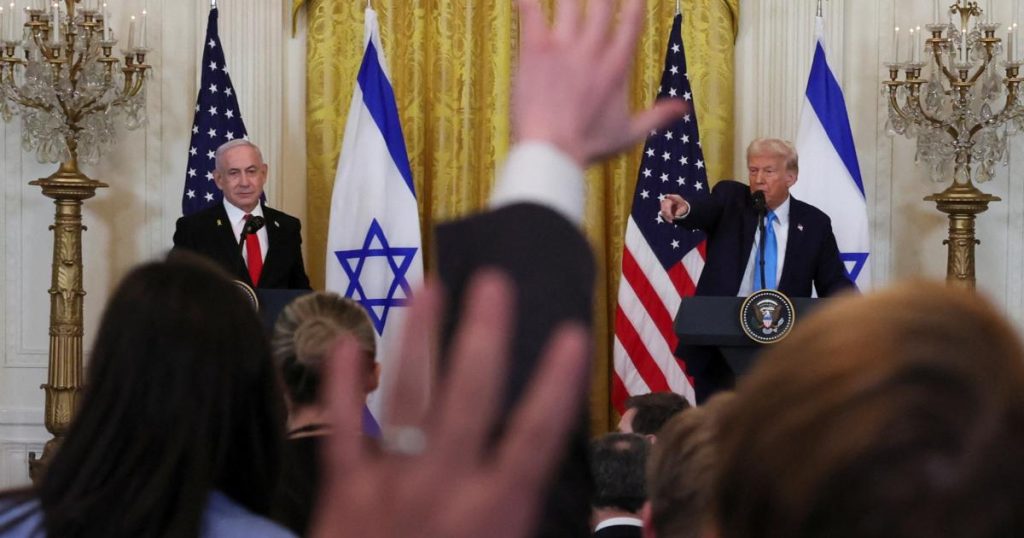The Middle East that U.S. President Donald Trump faces today features dangers and opportunities that were not present when he first took office, eight years ago. The greatest dangers are Iran’s advances toward nuclear weapons and the close relationships that the Islamic Republic has forged with Russia and China. The best opportunities have emerged from Israel’s decimation of Hezbollah and Hamas, its successful attacks on Iran, and the collapse of Bashar al-Assad’s regime in Syria.
The dangers are unquestionably grave. But on balance, the potential upsides outweigh the possible downsides. Indeed, it has been a long time since the Middle East has offered an environment so favorable to American interests.
A year and a half ago, Iran’s foreign policy could possibly have been considered enormously successful. The country’s nuclear weapons program was steadily producing enriched uranium; by 2024, it had enough for several bombs. Washington was largely not enforcing its sanctions on Iran. China was purchasing about 90 percent of Iran’s oil, greatly improving the regime’s finances. Political and military relations with China and Russia were growing closer; Iran had secured their protection against action in the UN Security Council and had earned money and gratitude from weapons shipments to Moscow. And the “ring of fire” of Iranian proxies and allies—Hezbollah in Lebanon, Hamas and Palestinian Islamic Jihad in Gaza, Shiite militias in Iraq and Syria, and the Houthis in Yemen—seemed to be a problem Israel could not solve.
But since then, Israel has turned the tables. Hamas has survived the invasion of Gaza that Israel carried out after the group’s attacks in October 2023, and Hamas remains dominant there. But it will never again pose a serious military threat to Israel. The Israelis have wiped out Hezbollah’s leadership and given Lebanon a chance to reclaim its sovereignty. Assad’s regime is gone, and the weapons highway that has long run from Iran through Syria to Lebanon—and to terrorist groups and their supporters in Gaza, Jordan, and the West Bank—appears to be closing.
Trump can take advantage of the situation, but only if his administration is willing to abandon Washington’s habitual goal in the Middle East—“stability”—and presses instead for dramatic changes that will benefit the security of the United States and its allies. For two decades, what American policymakers have called “stability” has meant the preservation of the situation in which Gaza was entirely under Hamas control, Hezbollah dominated Lebanon, and Iran’s nuclear program advanced. A better term for that situation would have been “erosion,” as U.S. influence steadily slipped away and Washington’s allies became less secure. Now, the United States has a chance to stop that process and aim instead for “reinforcement”: bolstering its interests and allies and actively weakening its adversaries. The result would be a region where threats diminish and U.S. alliances grow stronger.
THE TEHRAN TRAP
The main obstacle to the emergence of a better Middle East is Iran’s quest for a nuclear weapon. Trump has now stated flatly that the United States will not permit Iran to succeed. Iran’s supreme leader, Ali Khamenei, is now 85. As he contemplates the next four years, he will be tempted (and advised) to rush forward to a bomb as the only way to ensure his regime’s survival after he is gone. Trump has made it clear that such a move is precisely what would threaten the regime most gravely, because it would elicit not only more isolation but also, if necessary, a U.S. military attack. To make this threat more credible than it has been recently, Washington should begin visibly planning, preparing for, and practicing for such an attack, in coordination with Israel.
Trump has always favored a negotiated solution to the U.S.-Iranian standoff and still does; the objective of his “maximum pressure” campaign in 2019–20 was not regime change but a new and comprehensive deal to replace the flawed one that President Barack Obama made in 2015. Earlier this week, Trump wrote on his Truth Social account that instead of a U.S.-Israeli attack to prevent Iran from acquiring nuclear weapons, he would “much prefer a Verified Nuclear Peace Agreement which will let Iran peacefully grow and prosper.”
Trump clearly remains open to the possibility (however small) that an aging Khamenei, after witnessing the collapse of the “ring of fire” strategy, mulling the possibility of brutal economic sanctions, and being fully aware of the restiveness of his own population, would accept an agreement that stops the nuclear weapons program and halts payments and arms shipments to Iran’s proxies. But Trump should be equally aware of the trap Khamenei might be setting for him: a phony new negotiation meant to ensnare Washington in talks for years, with Tehran’s negotiators leading Trump on with the mirage of a successful deal and a Nobel Peace Prize at the end of the road while the Iranian nuclear weapons program grows in the shadows.
The United States is not alone in its confrontation with Iran.
To avoid that trap, Trump has correctly restored severe U.S. economic sanctions that will deprive Iran of resources. He must also push the International Atomic Energy Agency to demand tough inspections of Iran’s facilities. Trump should insist that Iran take immediate and concrete steps to show that it has abandoned its nuclear goal: for example, by beginning to export uranium enriched to 60 percent (or “downblending” it into lower enrichment levels) and by agreeing to allow inspections by the International Atomic Energy Agency at military sites that Iran has so far refused to open to the agency. If Tehran refuses to take those steps by this summer, Trump should urge France and the United Kingdom to invoke the UN Security Council “snapback” mechanism that reimposes all the UN sanctions Iran faced before it entered the 2015 nuclear deal—a mechanism created by that agreement, to which the British and French are still parties.
Iran will claim that the snapback would end the possibility of negotiations, but Trump should not be dissuaded by that ploy. It would still be possible to lift UN and U.S. sanctions later if the regime truly turned away from developing nuclear weapons. The fact that no country has ever enriched uranium to 60 percent, as Iran has, without building nuclear weapons is a reminder that getting Iran to abandon this path will be difficult. It will require the credible threat of military action—and may, in the end, require Washington to act on that threat.
But the United States is not alone in its confrontation with Iran—and Israel is not its only partner in this fight. American allies in the region all suffer from Iranian subversion and aggression. The willingness of Washington’s Arab friends to resist Iran has varied and depends on their estimation of U.S. reliability. The Saudi negotiations with Iran that China fostered in March 2023, for example, did not reflect a fundamental reorientation of Saudi foreign policy but a sensible defense mechanism at a moment of apparent U.S. weakness. The Saudi move reflected not only doubts about the Biden administration’s Iran policy but also the failure of the Trump administration to react when Iran attacked Saudi Arabia’s key oil facility at Abqaiq in September 2019. If Saudi Arabia and other Arab states judge that the United States has now decided to stop the Iranian nuclear weapons program and to continue to damage and weaken Iran’s proxies, they will adjust their policies accordingly. And it would become easier for Washington to repeat the kind of collaboration that occurred when Iran fired hundreds of missiles at Israel in April 2024—an attack that failed in part because a number of Arab states helped Israel and the United States repel it.
TIME FOR A RETHINK
There are limits, however, to what Trump can expect from the Saudis and other Arab states. It remains unclear, for example, whether Saudi Arabia can be fully included in the Abraham Accords, which Trump brokered in his first term, normalizing relations among Israel and a number of Arab countries. During the Gaza war, the Saudi government (and Crown Prince Mohammed bin Salman himself) moved from making ambiguous statements about Palestinian self-government to making clear demands for Palestinian statehood.
But turning over the West Bank to sovereign Palestinian rule is a losing proposition in the eyes of most Israelis, who believe that the Israeli withdrawal from Gaza in 2005 created the conditions that allowed Hamas to grow stronger and eventually carry out its massive attack on October 7, 2023. When it comes to the Palestinian question, it will be extremely difficult to bridge the gap between what the Saudis say they need and what Israeli politicians are willing to offer.
The prize the Saudis truly seek for normalizing relations with Israel, however, has nothing to do with the Palestinians: what Riyadh wants more than anything are defense agreements with the United States that would genuinely enhance Saudi security. Because an Israeli-Saudi accommodation would change not only the Middle East but Israel’s relations with the entire Muslim world, the Trump administration should see how far it can get. It should work with members of both American political parties to explore which forms of U.S.-Saudi defense arrangements might win congressional approval. A NATO-like treaty is one possibility. Another option would be a lesser guarantee of defense assistance, including making the kingdom a major non-NATO ally and guaranteeing it eligibility for advanced weapons systems.
Meanwhile, without embracing the demand for a Palestinian state as a time-bound and inevitable goal, Washington must find ways to make the idea of Palestinian self-government less threatening to Israel—at least in the West Bank. The corruption, incompetence, and unpopularity of the Palestinian Authority and the influence and popularity of Hamas understandably make Israelis view any increase in Palestinian self-rule as a danger. But in any scenario other than a complete Israeli annexation of the West Bank in a “one-state solution,” which most Israelis oppose, there must be some legitimate and competent Palestinian governing entity—albeit not necessarily the Palestinian Authority that was established by the Oslo Accords.

The participation of Hamas in Palestinian self-government is unacceptable to Israel and the United States. The Biden administration spoke often of a “reformed Palestinian Authority” as the best option but did nothing to usher such a thing into existence. Twenty years ago, the George W. Bush administration (in which I served) successfully demanded real reforms from the PA. The United States pushed hard for the appointment of officials of integrity and competence (including Salam Fayyad, who served as the PA’s prime minister from 2007 to 2013), the adoption of financial management standards, and the dismissal of a number of the most corrupt officials from the PA’s dominant Fatah faction. Today, the United States and key Arab countries should demand similar changes from the PA’s president, Mahmoud Abbas. Such pressure could once again produce a better PA. The Trump administration should insist that Washington’s Arab allies use their leverage over the PA and that the Authority accede to their demands as a precondition of continued U.S. support.
Whether one favors moves toward a Palestinian state in the coming years or believes that full Palestinian statehood would present insuperable dangers to Jordan, Israel, and Palestinians alike, all parties should support the goal of better government for Palestinians. But any increase in Palestinian self-rule will require immediate changes to the status quo. UNRWA, the UN agency that has provided international aid to Palestinians, has been hopelessly compromised by its ties to Hamas, and the agency’s definition of “Palestinian refugees” as a population that endlessly grows with each successive generation is fundamentally at odds with the acceptance of Israel’s status as a Jewish state. The Trump administration, which has ended U.S. funding for UNRWA, should insist that it be replaced by the collaborative efforts of effective UN agencies such as the World Food Program, UNICEF, and the UN High Commissioner for Refugees.
Israel’s contribution to this effort should be to enforce its laws against settlers who engage in criminal activity against Palestinians, whether it is the destruction of crops or acts of violence against individuals. And it should prevent settler groups from declaring land in the West Bank to be Israeli territory without any legal backing or formal government decisions.
Trump’s proposal that the United States “take over” and rebuild Gaza while its residents live elsewhere has added a new wrinkle to the Israeli-Palestinian dispute. As a concrete proposal, it is unworkable. But it might better be seen as a reflection of the fact that no realistic plan for Gaza exists. Since 2005, when the Israelis withdrew settlements and military forces from Gaza, Israel, the United States, and the United Nations have tried to buy off Hamas while working with corrupt PA officials. That approach has produced zero progress—and indeed culminated in the October 7 attacks. Despite the outlandishness of Trump’s idea, its sheer iconoclasm might lead to a healthy rethinking of U.S. strategy and perhaps of Arab and Israeli policies as well.
A NEW LEVANT?
To Israel’s north, the weakening of Hezbollah should be seen not as a completed achievement but as a first step toward a very different Levant. The next step should be for Trump to include Lebanon in the Abraham Accords. For decades, U.S. policy has accepted weak and corrupt Lebanese institutions as normal and inevitable. Washington has also accepted a twisted form of Lebanese nationalism that cast Israel as the enemy but celebrated Iran and Syria’s subjugation and domination of Lebanon. Trump should demand that the Lebanese armed forces prevent an armed Hezbollah presence in the south and guard Lebanon’s borders to prevent Iranian arms supplies from entering. If it fails to fully deploy in southern Lebanon and does not begin the process of disarming Hezbollah, Washington should suspend its considerable aid to the Lebanese military.
Critics will contend that cutting off the Lebanese armed forces will weaken their position. But just as endlessly funding the PA with few strings attached did not produce success, so, too, did unconditional support for the hapless Lebanese military, which wasted a fortune while Hezbollah only grew stronger. Trump should also insist that Lebanon negotiate with Israel to address onshore and offshore border disputes. Put simply, U.S. diplomatic, political, and financial support for Lebanon should depend on that country’s efforts to regain its sovereignty. The more pressure that can be applied, including through U.S. cooperation with Gulf states and with France, the more likely it is that Lebanese leaders who want to build a responsive, sovereign government can succeed.
Across the border in Syria, it is too soon to know what form of government will emerge in the wake of the Assad regime’s collapse. But it is not too soon to know what the U.S. goal there should be: the evolution of a legitimate government based on popular consent that ceases Syrian interference in Lebanon and seeks peace with all its neighbors, including Israel. U.S. support for any new Syrian government should depend on the government’s actions, not on President Ahmed al-Shaara’s speeches or his new, Western-style wardrobe. Does Syria end or severely limit the size and nature of the Russian presence at what were Moscow’s two key bases in Syria, the Khmeimim Air Base and the naval base in Tartus? How does Shaara’s government treat minorities, especially the Kurds and the Syrian Democratic Forces militia the United States has long supported? Does it try to stop Iran from supplying money and weapons to Hezbollah through Syria? Trump’s approach should be informed by the answers to those questions.
In the meantime, it would be immensely foolish for Trump to withdraw the roughly 2,000 U.S. troops stationed in Syria because they are there to fight the Islamic State terrorist group (also known as ISIS) and to keep tens of thousands of former ISIS fighters and their families in detention. It should also be U.S. policy to maintain Washington’s partnership with the Kurdish-led Syrian Democratic Forces until the militia’s status (whether as an independent force or as a semiautonomous part of the Syrian army) and future safety are secured.
Israel has successfully decimated (though not eliminated) Hamas and Hezbollah. But the Houthis, another Iranian proxy, still threaten international shipping and U.S. Navy vessels in the Red Sea—with Iranian weapons. The Houthis have claimed to act in support of the Palestinians, but it’s unclear whether their recent decision to suspend most of their attacks reflects the cease-fire in Gaza alone or also their fear of a stronger U.S. response under Trump. Either way, Trump should make it clear to Iran that if any U.S. Navy ship is damaged or any American hurt or killed by these weapons, there will be an immediate U.S. military response against Iran. And he should tell the Houthis that should they recommence their attacks on international shipping, U.S. forces will attack their facilities and interdict all weapons-supply shipments intended for them.
THE FALSE PROMISE OF STABILITY
U.S. relations with Israel saw high points during the Biden years but also some low ones. While supporting Israel’s war on Hamas, President Joe Biden also sought to appease critics of Israel on the left (and even inside his own State Department and White House) by continually complaining about how Israel was conducting the war, delaying the supply of some U.S. military assistance (including armored bulldozers and certain munitions), and sanctioning dozens of Israeli settler groups and individuals. Trump quickly released the withheld shipments and removed the sanctions, signaling that the Trump administration is highly unlikely ever to withhold or deliberately slow military aid to Israel. Israel’s military strength, after all, is a multiplier of American power and advances U.S. interests.
But Trump should go beyond announcing full support of Israel and opposition to an Iranian nuclear weapon. For decades, conventional wisdom held that Arab-Israeli rapprochement was impossible until the Palestinian issue was resolved, but Trump’s Abraham Accords proved that wrong. Today, he should seek not the false stability of an endless deadlock with Iran but a transformation of the region—reinforcing the changes that Israel has already achieved by weakening Hamas in Gaza and Hezbollah in Lebanon, demonstrating Iran’s military vulnerability, and setting the stage for the overthrow of the Assad regime.
The United States now has a chance to keep Iran and its allies off balance. Because the only true solution to the problem of the Islamic Republic is its demise, the United States and allies should mount a pressure campaign on behalf of the Iranian people—who wish for the regime’s end more fervently than any foreigner. These efforts should include exposing the regime’s repression and human rights abuses and carrying out political warfare on the regime: constant criticism of its economic failings and brutality, support for Iran’s neighbors if Iran threatens them, and aid (overt and covert) for efforts by Iranians to protest a regime most of them clearly loathe.
President Ronald Reagan’s relations with the Soviet Union are a reminder that it is possible to engage in practical negotiations with an enemy state without losing the sharp edge of ideological combat. An American president can talk to an authoritarian adversary without sacrificing moral clarity and without dropping support for people yearning to be free of a repressive regime and often demonstrating in the streets, despite the risks.
The United States should always view such negotiations as a tactic in the long struggle for a peaceful Middle East—a goal that cannot be reached until the Islamic Republic is replaced by a government that is legitimate in the eyes of the Iranian people and that abandons its terrorist proxies, its hatred of the United States and of Israel, and its desire to dominate other countries in the region. Until that day, the military presence of the United States must not diminish. To hasten the arrival of such a day, Trump should maximally exploit Washington’s advantages, which were created in good part by Israeli action. In four years, Trump could leave behind a Middle East where Washington’s friends are far stronger and its enemies far weaker than ever before.
Loading…








